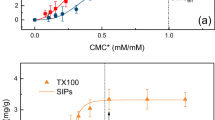Abstract
Surfactants have been used for environmental remediation to remove hydrophobic organic compounds (HOCs) in water and soil. However, there are limited studies on the use of surfactants in confined micelle arrays to remove pesticides and polycyclic aromatic hydrocarbons from water. We studied the recovery of HOCs using two confined surfactants: nonionic Triton X-100 and cationic 3-(trimethoxysily)propyl-octadecyldimethyl-ammonium chloride (TPODAC). The micelle arrays were confined on a mesoporous silica matrix deposited onto a magnetic iron core. These magnetic, dispersible sorbents can be used to recover HOCs, minimizing the application of surfactants when compared to soil-washing techniques. The TPODAC-based sorbent had better average recovery of the HOCs studied compared to the Triton-X sorbent, and was, in general, comparable to activated carbon. It performed well with the chlorinated pesticides, in part due to additional interactions between the cationic sites and the polar compounds.






Similar content being viewed by others
References
Anbia, M., & Lashgari, M. (2009). Synthesis of amino-modified ordered mesoporous silica as a new nano sorbent for the removal of chlorphenols from aqueous media. Chemical Engineering Journal, 150, 555–560.
Chu, W. (2003). Remediation of contaminated soils by surfactant-aided soil washing. Practice Periodical of Hazardous, Toxic, and Radioactive Waste Management, 7(1), 19–24.
Doong, R., Lei, W., Chen, T., Lee, C., Chen, J., & Cheng, W. (1996). Effect of anionic and nonionic surfactants on sorption and micellar solubilization of monocyclic aromatic compounds. Water Science and Technology, 34, 327–334.
Hawthorne, S. B., Grabanski, C. B., Miller, D. J., & Kreitinger, J. P. (2005). Solid-phase microextraction measurement of parent and alkyl polycyclic aromatic hydrocarbons in milliliter sediment pore water samples and determination of K(DOC) values. Environmental Science & Technology, 39(8), 2795–2803.
Kim, J., Shim, S., & Shim, J. (2003). Synthesis of amphiphilic polyurethane nanonetwork particles and their application for the soil-washing process. Journal of Applied Polymer Science, 87(10), 1666–1677.
Laha, S., Tansel, B., & Ussawarujikulchai, A. (2009). Surfactant–soil interactions during surfactant-amended remediation of contaminated soils by hydrophobic organic compounds: a review. Journal of Environmental Management, 90, 95–100.
McDonough, K. M., Fairey, J. L., & Lowry, G. V. (2008). Adsorption of polychlorinated biphenyls to activated carbon: equilibrium isotherms and a preliminary assessment of the effect of dissolved organic matter and biofilm loadings. Water Research, 42, 575–584.
Mohan, S. V., Kisa, T., Ohkuma, T., Kanaly, R. A., & Shimizu, Y. (2006). Bioremediation technologies for treatment of PAH-contaminated soil and strategies to enhance process efficiency. Reviews in Environmental Science and Biotechnology, 5(4), 347–374.
Paria, S. (2008). Surfactant-enhanced remediation of organic contaminated soil and water. Advances in Colloid and Interface Science, 138, 24–58.
Park, J. W., & Jaffe, P. R. (1993). Partitioning of three nonionic organic compounds between adsorbed surfactants, micelles, and water. Environmental Science & Technology, 27(12), 2559–2565.
Schwarzenbach, R. P., Gschwend, P. M., & Imboden, D. M. (2003). Environmental Organic Chemistry. New York City: Wiley.
Wang, P., & Keller, A. A. (2007). Partitioning of hydrophobic organic compounds within soil–water–surfactant systems. Water Research. doi:10.1016/j.watres.2007.11.015.
Wang, P., & Keller, A. A. (2008a). Adsorption of hydrophobic organic compounds onto a hydrophobic carbonaceous geosorbent in the presence of surfactants. Environmental Toxicology and Chemistry, 27(6), 1237–1243.
Wang, P., & Keller, A. A. (2008b). Soil particle-size dependent partitioning behavior of pesticides within water–soil–cationic surfactant systems. Water Research, 42(14), 3781–3788.
Wang, P., & Keller, A. A. (2008c). Particle-size dependent sorption and desorption of pesticides within a water–soil–nonionic surfactant system. Environmental Science & Technology, 42, 3381–3387.
Wang, P., Shi, Q., Shi, Y., Clark, K. K., Stucky, G. D., & Keller, A. A. (2009). Magnetic permanently confined micelle arrays for treating hydrophobic organic compound contamination. Journal of the American Chemical Society, 131(1), 182–188.
Acknowledgments
We thank Annabelle Lee and Lydia Sannella for their assistance in dosing the sorbents and running the HPLC and UV-Vis spectrometry measurements. This material is based partially upon the work supported by the Science Mathematics and Research for Transformation (SMART) Program and the National Science Foundation (NSF) and the United States Environmental Protection Agency (USEPA) under Cooperative Agreement Number DBI-0830117. Any opinions, findings, and conclusions or recommendations expressed in this material are those of the authors and do not necessarily reflect the views of the NSF or the USEPA. This work has not been subjected to USEPA review, and no official endorsement should be inferred.
Author information
Authors and Affiliations
Corresponding author
Rights and permissions
About this article
Cite this article
Clark, K.K., Keller, A.A. Investigation of Two Magnetic Permanently Confined Micelle Array Sorbents Using Nonionic and Cationic Surfactants for the Removal of PAHs and Pesticides from Aqueous Media. Water Air Soil Pollut 223, 3647–3655 (2012). https://doi.org/10.1007/s11270-012-1138-0
Received:
Accepted:
Published:
Issue Date:
DOI: https://doi.org/10.1007/s11270-012-1138-0




